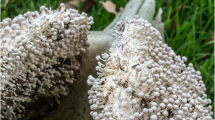Abstract
In this paper it is described for the first time the capability of Myrothecium verrucaria to grow in submerged and solid state cultures using poultry feathers as the only substrate. The fungus produced a protease with an unusual keratinolytic activity among plant pathogenic fungi. Its crude protease hydrolyzed keratinous substrates at pH 9.0 and 40 °C in the following order: poultry feather keratin > sheep wool keratin > human nail keratin > human hair keratin. Protease activity was highly sensitive to phenylmethyl sulphonyl fluoride (PMSF) indicating that the enzyme belonged to the serine protease family.
Similar content being viewed by others
References
Fuchs E (1995). Keratins and the skin. Annu Rev Cell Dev 11: 123–153
Safranek WW and Goos RD (1982). Degradation of wool by saprophytic fungi. Can J Microbiol 28: 137–140
Gradisar H, Friedrich J, Krizaj I and Jerala R (2005). Similarities and specificities of fungal keratinolytic proteases: comparison of keratinases of Paecilomyces marquandii and Doratomyces microsporus to some known proteases. Appl Environ Microbiol 71: 3420–3426
Ramnani P and Gupta R (2004). Optimization of medium composition for keratinase production on feather by Bacillus licheniformis RG1 using statistical methods involving response surface methodology. Biotechnol Appl Biochem 40: 191–196
Onifade AA, Al-Sane NA, Al-Musallam AA and Al-Zarban S (1998). A Review: Potentials for biotechnological applications of keratin-degrading microorganisms and their enzymes for nutritional improvement of feathers and others keratins as livestock feed resources. Biores Technol 66: 1–11
Moallaei H, Zaini F, Larcher G, Beucher B and Bouchara J.-P (2006). Partial purification and characterization of a 37 kDa extracellular proteinase from Trichophyton vanbreuseghemii Mycopathologia 161: 369–375
Chitte RR, Nalawade VK and Dey S (1999). Keratinolytic activity from the broth of a feather-degrading thermophilic Streptomyces thermoviolaceus strain SD8. Lett Appl Microbiol 28: 131–136
Rozs M, Manczinger L and Kevei F (2001). Secretion of a trypsin-like thiol protease by a new keratinolytic strain of Bacillus licheniformis. FEMS Microbiol. Lett. 205: 221–224
Riffel A and Brandelli A (2006). Keratinolytic bacteria isolated from feather waste. Braz J Microbiol 37: 395–399
Kushwaha RKS and Nigam N (1996). Keratinase production by some geophilic fungi. Proc. Indian Natl Sci Acad B Biol Sci 19: 107–109
Bahuguna S and Kushwaha RKS (1989). Hair perforation by keratinophylic fungi. Mycoses 32: 340–343
Anbu P, Gopinath SCB, Hilda A, Lakshmipriya G, Annadurai G. Optimization of extracellular keratinase production by poultry farm isolate Scopulariopsis brevicaulis. Biores Technol 2006 (in press)
Santos RMDB, Firmino ALP, de Sá CM and Felix CR (1996). Keratinolytic activity of Aspergillus fumigatus Fresenius. Cur Microbiol 33: 364–370
Grazziotin A, Pimentel FA, de Jong EV, Brandelli A. Nutritional improvement of feather protein by treatment with microbial keratinase. Ani Feed Sci Technol 2006; 126: 135–144
Choi JM, Nelson PV. Developing a slow-release nitrogen fertilizer from organic sources. 2. Using poultry feathers. J. Am Soc Horticul Sci 1996; 121: 634–638.
Dalev P and Neitchev V (1991). Reactivity of alkaline proteinase to keratin and collagen containing substances. Appl Biochem Biotechnol 27: 131–138
Gupta R and Ramnani P (2006). Microbial keratinases and their prospective applications: An overview. Appl Microbiol Biotechnol 70: 21–33
Dobinson KF, Lecomte N and Lazarovits G (1996). Can J Microbiol 43: 227–233
North MJ (1982). Comparative biochemistry of the proteinases of eukaryotic microorganisms. Microbiol Rev 46: 308–340
Pekkarinen A, Mannonen L, Jones BL and Niku-Paavola M.-L (2000). Production of proteases by Fusarium species grown on barley grains and in media containing cereal proteins. J Cereal Sci 31: 253–261
Raymond FL, Etchells JL, Bell TA and Masley PM (1959). Filamentous fungi from blossoms ovaries, and fruit of pickling cucumbers. Mycologia 51: 492–511
Ryan CA (1973). Proteolytic enzymes and their inhibitors in plants. Annu Rev Plant Physiol 24: 173–196
Carpita NC and Gibeaut DM (1993). Structural models of primary cell walls in flowering plants: Consistency of molecular structure with the physical properties of the walls during growth. Plant J 3: 1–10
Griffin DH. Fungal physiology. Wiley-Liss John Wiley & Sons, Inc. Publ, 1994
Nguyen TH, Mathur SB and Neergaard P (1973). Seed-borne species of Myrothecium and their pathogenic potential. Trans Br Mycol Soc 61: 347–354
Heyn ANJ (1958). The occurrence of Myrothecium on field cotton. Text Res J 28: 444–445
Romano AB (1979). Sunfl Newslett 3: 8–10
Farr DF, Bills GF, Chamuris GP and Rossman AY (1989). Fungi on Plants and Plant Products in the United States. American Phytopathological Society, St. Paul, Minn
Stevenson JA and McColloch LP (1947). Plant Dis Rep 31: 147–149
Singh M and Aujla SS (1967). Rev Appl Mycol 46: 368–375
Yang SM and Jong SC (1995). Host range determination of Myrothecium verrucaria isolated from leafy spurge. Plant Dis 79: 994–997
Moreira FG, Reis S, Costa MAF, Souza CGM and Peralta RM (2005). Production of hydrolytic enzymes by the plant pathogenic fungus Myrothecium verrucaria in submerged cultures. Braz J Microbiol 36: 7–11
Peterson GL (1977). A simplification of the protein assay method of Lowry et al. which is more generally applicable. Annu Rev Biochem 83: 346–356
McIlvaine TC (1921). A buffer solution for colorimetric comparison. J Biol Chem 49: 183–186
Starcher B (2001). A ninhydrin-based assay to quantify the total protein content of tissue samples. Anal Biochem 292: 125–129
Dozie INS, Okeke CN and Unaeze NC (1994). World J Microbiol Biotechnol 10: 563–567
Farag AM and Hassan MA (2004). Enz Microbial Technol 34: 85–93
Gradisar H, Kern S and Friedrich J (2000). Appl Microbiol Biotechnol 53: 196–200
Malviya HK, Rajak RC and Hasija SK (1992). Mycopathologia 119: 161–165
Monod M, Capoccia S, Léchenne B, Zaugg C, Holdom M and Jousson O (2002). Secreted proteases from pathogenic fungi. Int J Med Microbiol 292: 405–419
Bockle B, Müller R. Reduction of disulfide bonds by Streptomyces pactum during growth on chicken feathres. Appl Environ Microbiol 1997; 63: 790–792.
Author information
Authors and Affiliations
Corresponding author
Rights and permissions
About this article
Cite this article
Moreira, F.G., de Souza, C.G.M., Costa, M.A.F. et al. Degradation of keratinous materials by the plant pathogenic fungus Myrothecium verrucaria . Mycopathologia 163, 153–160 (2007). https://doi.org/10.1007/s11046-007-0096-3
Received:
Accepted:
Published:
Issue Date:
DOI: https://doi.org/10.1007/s11046-007-0096-3




